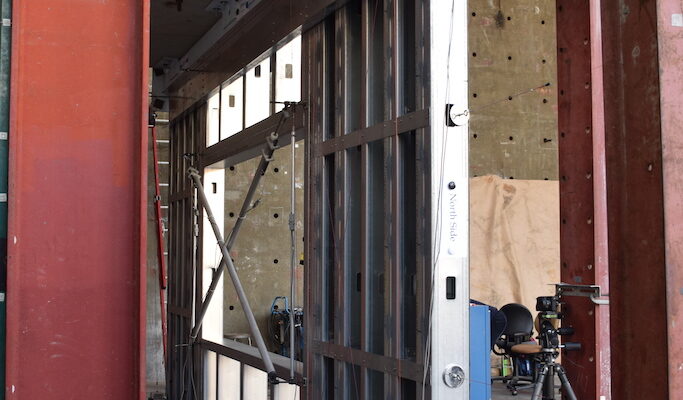In the first phase of CFS-NHERI wall-line testing, cold-formed steel (CFS)-framed wall-line assemblies (shear walls in-line with gravity walls) were tested at the Large High Performance Outdoor Shake Table (LHPOST) at University of California, San Diego, by subjecting them to earthquake motions of increasing intensity. More details and videos from the shake table test phase can be found at https://cfsrc.org/2020/05/26/shake-table-tests-of-steel-sheet-sheathed-shear-walls/.
Expanding on the shake table test phase, the quasi-static test phase, conducted in Fall 2019, included testing of ten wall-line specimens tested at the UC San Diego Structural Engineering Powell Laboratory by imposing a reverse cyclic displacement-controlled loading CUREE protocol. Shear wall segments were detailed with tie-down assemblies consisting of compression stud packs studs and either continuous tension tie-rods or traditional hold-downs, with a single side sheathed with steel sheet. The various configurations in the test matrix include specimens in an unfinished or finished, symmetric or unsymmetrical, Type I or Type II design configuration, and with or without a window opening.
One of the most important observations from the two test phases were the substantial increases in wall strength, stiffness, and energy dissipation capacity due to exterior and interior finish application. The EIFS (exterior insulation finishing system) layer and interior gypsum panels added 635 lb/ft and 370 lb/ft of additional strength, respectively, on average. The elastic stiffness also increased by 1.5-3 times. The dissipated energy was also calculated to be two to three times higher for finished configurations. Results from these tests regarding finishes have also been included in the commentary section of AISI S400-20 design code. The progressive damage to the finish layers as the specimen undergoes higher drift amplitude cycles can be seen here (SGGS-1HDF.mp4, SGGS-1HDF West Cam All.mp4).
Several other observations and results from the two test phases, such as higher lateral strength for walls installed with hold-downs compared with tension tie-rod system, differences in the behavior of Type I and Type II shear walls etc. have been documented in two companion papers published recently in the Journal of Structural Engineering (https://doi.org/10.1061/(ASCE)ST.1943-541X.0003433, https://doi.org/10.1061/(ASCE)ST.1943-541X.0003434).
Several videos demonstrating the behavior of all the tested wall-line specimens can be found at the link below. https://drive.google.com/drive/folders/1yS9s1n9jz5pWhlXN9HWrjZbGtU5iglc5?usp=sharing
Test reports, containing in-depth test results, as well as all of the high quality data generated during the experimental program is publicly available within the DesignSafe-CI repository (https://doi.org/10.17603/ds2-mvj8-8386, https://doi.org/10.17603/ds2-encf-vj32).


